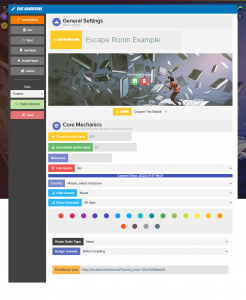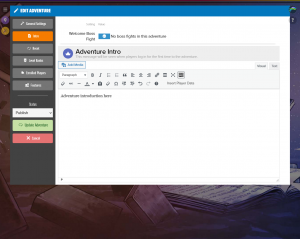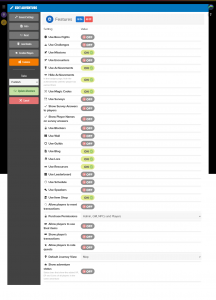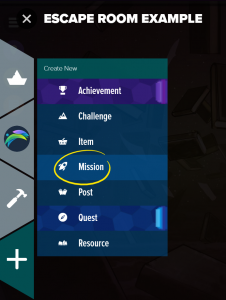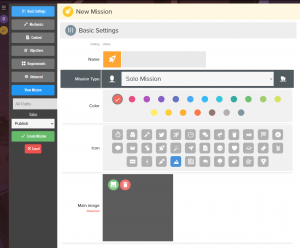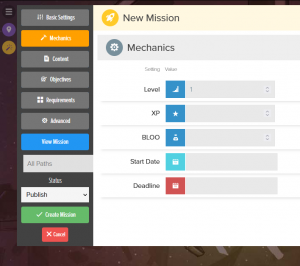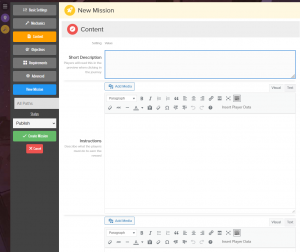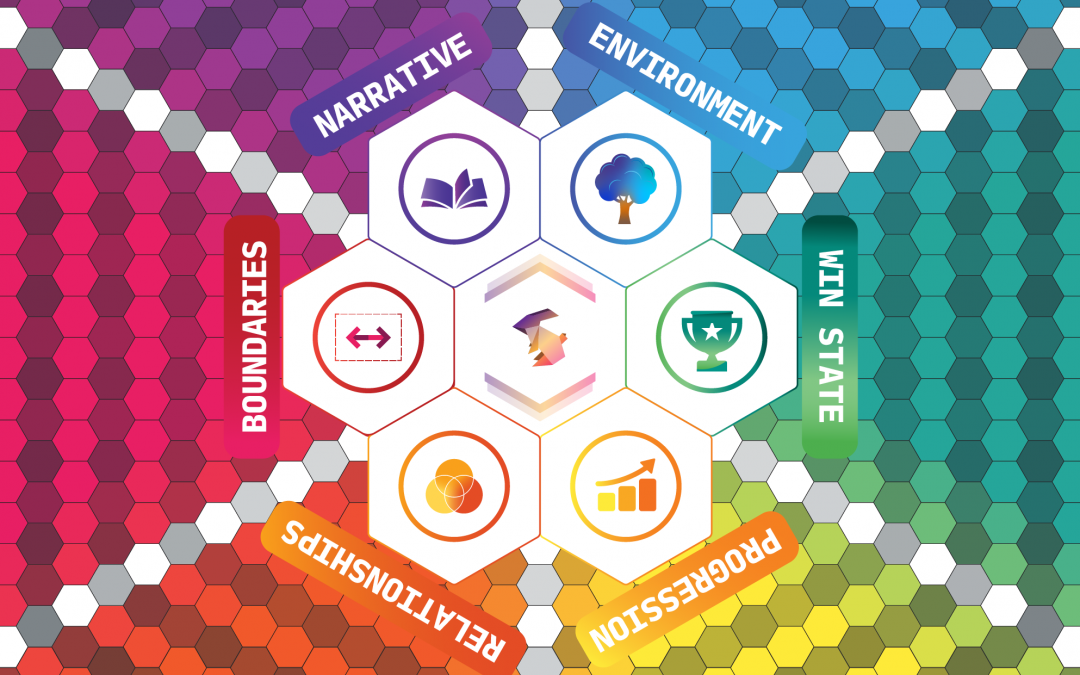
by Bernardo | Jul 11, 2022 | Framework 2022, Gamification
After a couple of years of using and training others in the use of our old framework, I finally decided it’s time to give it a spin and update in several ways.
The first thing I wanted to do is use what we have learned from the industry and simplify the system so it’s a lot easier to create a gamified environment. Doing that isn’t easy. It took about three years of work and testing.
I finally redesigned it.
Some of our steps were disordered from a natural flow so we changed them. I also realize several steps were out of place or many players didn’t use them at all so I made those steps optional in case someone wants to dive deeper in their designs.
So let’s do this!!
All new cards and new frame!
by Bernardo | Feb 19, 2022 | Education, Gamification
My wife was just talking to my daughter Hana. She casually said “Let’s go to the fridge and play ‘letters'”. We bought those magnetic letters that you put on the fridge to write whatever you’d like… Not too much of a story there but the meaning behind those words is the motto of BLUERABBIT.
For the past years I’ve been saying at the end of every talk a phrase I used to tell my dad when I was eight.
Life is a game. The thing is that when we grow up we get to play for real.
So imagine you approach your next writing assignment as “Let’s play letters” instead of “I must write a 5000 words article”
I think we can approach life like this. All of us, like a one and a half year old learning such a complex thing as the alphabet by “playing letters”
by Bernardo | Jan 14, 2022 | Tutorials
Create an Escape Room in BLUERABBIT
Overview
Alright. This post is coming after the Game Garage on the 14th of January. If you want to know what the game garage is, visit Sententia Gamification website as they are holding the best gathering of gamification peers, enthusiasts, experts and newbies together with a great new idea every single time.
How do you create an Escape Room with BLUERABBIT?
Well, first of all, what is an escape room?
An escape room is an activity where the players have to find clues in order to solve a riddle. The consequence of solving the riddle is “escaping the room” where you were locked (not really locked, this isn’t a terror movie).
So within BLUERABBIT you can create all the elements that are needed for an escape room to exist and you can use the software to provide feedback to the players against the clues they find in the process.
20 Achievements that will provide clues to get the 10 digit code.
20 Blog Posts, each providing media to figure out 20 keywords.
1 Mission with instructions.
What you will make
IN THIS TUTORIAL
An escape room with a goal to find a 10 digit code.
Outside BLUERABBIT
- The Goal: The secret code, the last key, the name, the contract, the combination of the safe, etc…
- Clues: The parts of the puzzle, numbers to the combination, the key to the safe, etc…
Inside BLUERABBIT
- A new Adventure: The place where the players will play.
- Blog Posts, Achievements and Items: The mechanics where you put the clues.
- Adventure Intro & Mission for instructions: A place to put the goal and include the instructions on how to solve the escape room.
Resources
Open up this spreadsheet. It has all clues, keywords and the 10 digit code. It also has tips on good practices.
Each CITY NAME correspond to a matching media file you can download HERE.
Three of those images are QR codes that link to media files stored in BLUERABBIT.
Steps to create the escape room
>>> IMPORTANT <<<
If you need to edit anything you made and can’t find it, just go to the hamburger menu > TOOLS (the hammer) > Manage Adventure. There you can edit everything you create.
1. Create a new Adventure
3. Create a new Blog Post for every clue
Step 1: Create the post
|
|
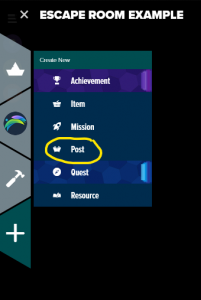 |
- Go to the hamburger menu on the top left.
- Click on the last button (the + sign)
- Add new Post
|
Step 2: Post Settings
|
|
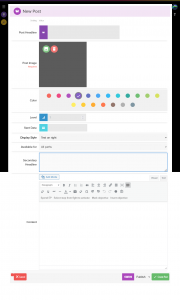
|
- The headline should not give away any information. I always just put a generic “Found Something” label.
- You can use the image that will provide the clue as the Post Image.
- Choose a color. It’s important for readability
- Level -> 1
- Display style: Choose whatever you like, there are four styles, makes no difference but helps visually when looking for clues to add some variation.
- Secondary headline > Leave empty
- Content > Add the Image that is the clue. You may add some phrase that will help with a bit of context as long as it doesn’t give away the theme or something else.
|
Step 3: Save the Post
|
Rinse and repeat for every clue |
4. Create a new Achievement for every clue
Step 1: Create the achievement
|
|
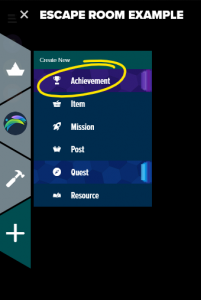 |
- Go to the hamburger menu on the top left.
- Click on the last button (the + sign)
- Add new Achievement
|
Step 2: General Settings
|
|
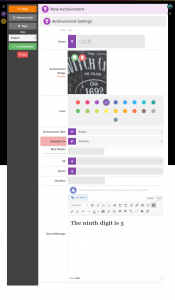
|
- The achievement name should be just CLUE. Don’t number them it makes things stressful for the players.
- Use the image of the clue for reference. That way players can keep track of what they have solved.
- Choose color
- Achievement type: Badge
- Available for All Paths
- Max Players : Empty or Zero to have no limit
- XP: 500
- BLOO / Coins: 50
- Deadline: Empty
- Content: The part of the clue that will solve the 10 digit code. From the spreadsheet, the content of the column “clue”
|
Step 3: Achievement Codes
|
Switch tabs on the upper left. |
|
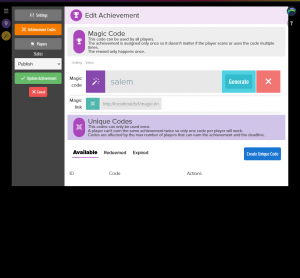
|
In the Magic Code field, add the KEYWORD for this clue. You can add phrases (keywords with spaces) just make sure that there isn’t a space at the end or the players will never solve that clue. |
Step 4: Add one extra achievement for the final code
Add one more achievement so that the players can solve the escape room. Just make another one but the with the 10 digit number as the magic code.
Add a cool image for those who manage to solve it.
|
|
And that’s it. You just created a complete escape room in BLUERABBIT!
Tell us how did it go! And don’t hesitate to call for help. That’s what we are here for.
Try BLUERABBIT
Try it for free. No commitment, no upfront, no nothing. Just register and start building.
by Bernardo | Nov 15, 2021 | Gamification
For the past years the gamification community has been using the term gamification defined as “the use of game-mechanics or game-elements in a non-game context” and that has brought a lot of confusion and discussion in the industry.
Primarily the main problem lies behind how words are written (those bastards at Webster!!). @Andrzej Marczewski puts it very clearly in his latest entry:
Take the word beautify as an example. The Oxford dictionary defines that simply as “make beautiful”. Whilst we are thinking of the word simply, it also defines simplify as “make simple”.
So, it stands to reason that the layperson would look at the word gamify and assume it means “make gameful” or just “make game-like” (as gameful isn’t really in common language still). And, as we are looking at this from the layperson perspective – I’m throwing in the word game as well, not just game-like!
Almost every time he writes something the industry kind of shakes a bit. At least it helps us all brush the dust on some things we take for granted and remember the basics.
Merriam Webster’s definition still stands like this:
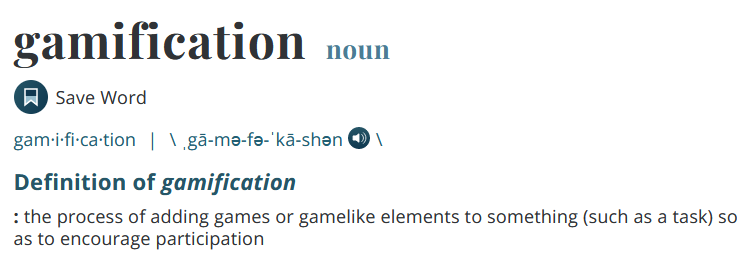
The problem with this definition is that it leaves a lot of components to interpretation and complicates everything for experts, newbies, stake holders, customers, clients, participants, players and your dog if they ever heard the word.
The new proposed definition by @Andrzej is a lot simpler, easier to understand to anyone AND the most important thing, it works.
So I’m jumping on this boat and will update my current material accordingly as this is the result and evidence of years of work from hundreds of experts in the industry.
Gamification is the process of making something a game or game-like.
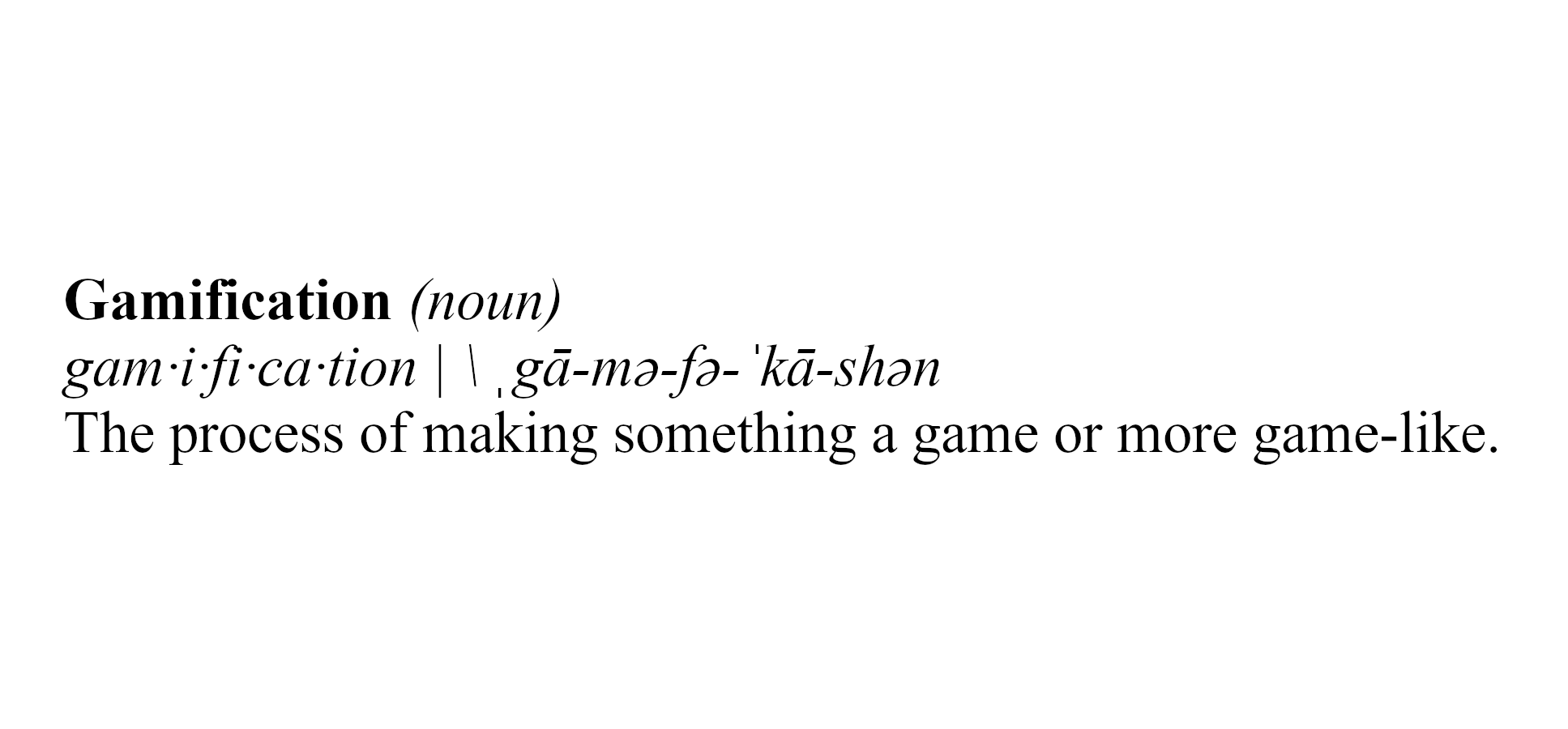
End of discussion. At least for another ten years I hope.
by Bernardo | Feb 22, 2021 | Gamification
Alright!!! So for all of you attending Gamicon 21v (https://gamicon.us)
What you need to do to build a player journey using an analogue version of BLUERABBIT is this:
- Assumption just for this case >>> You are in charge of running a learning experience.
- The Problem for this scenario >>> The participants don’t engage with the players.
- The tools at hand to increase engagement are:
- QUESTS >>> A way of submitting content. Whatever it is, text, image, links, videos or documents. It can come in the shape of a survey or with steps to complete. The core point of a quest is that the content is not evaluated but required.
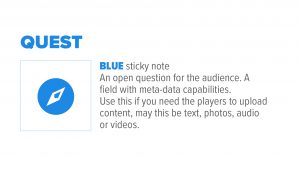
- CHALLENGES >>> A way of measuring knowledge in the form of multiple choice quizzes.
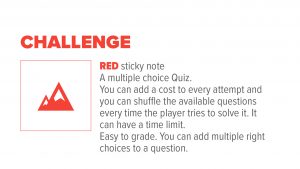
- ACHIEVEMENTS >>> It’s a tool to award resources that neither the quest or the challenge cover. It can be scanning a QR code they find in their email or the physical mail or under a table (when COVID stops). It can be actively recognizing the best question made to a speaker or anything.
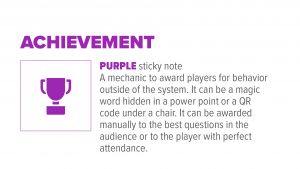
- Follow the engagement loop:
PROMPT > ACTION > PROCESS > CONSEQUENCE > CHANGE > FEEDBACK > PROMPT >
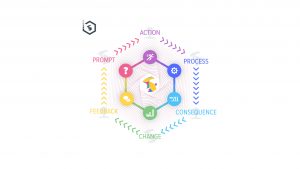
Now. The challenge is to create THREE activities choosing your tools. any combination of those tools and you ask something of the players. The only thing that’s open for you is the subject. So let’s say you want the players to learn about apples. What are the three first activities related to apples you want the player to do/learn?
Maybe 2 quests and a challenge:
- Quest 1 > Upload a picture of your favorite apple
- Quest 2 > Tell us what is the best apple and why?
- Challenge > Answer these three simple questions about apples


